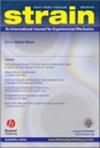3D打印和注塑玻璃纤维增强聚丙烯的显微结构特征通过图像分析,模拟和实验方法
IF 2.4
3区 材料科学
Q2 Engineering
引用次数: 0
摘要
为了尽可能精确地通过数值模拟来预测纤维增强热塑性塑料的宏观行为,多年来人们对纤维增强热塑性塑料的力学性能及其与制造工艺、纤维性能、纤维浓度和应变速率的关系进行了深入研究。在真实和虚拟实验中纳入微观结构,显著提高了注塑玻璃纤维增强热塑性塑料的预测精度。在这项工作中,我们将三种既定的表征和建模方法应用于注塑和3D打印材料。通过分析重建的层析成像图像,确定了纤维组分的几何特性,如纤维取向、纤维长度和纤维直径分布。为了比较纤维长度,采用了最近提出的一种新方法。基于层析图像的分割,在微观尺度上对两种复合材料的弹性刚度进行了数值计算。最后,通过微拉伸试验对两种材料的力学行为进行了实验表征。对于注射成型材料,模拟结果与实测刚度吻合较好。然而,对于3D打印材料,测量和模拟有很大的不同。模拟的预测结果与显微组织图像分析结果的预测值一致。因此,测量行为的差异必须归因于基体材料。这证明了对3D打印材料进一步研究的需求,可预测的原型,预生产系列和可能的系列应用。本文章由计算机程序翻译,如有差异,请以英文原文为准。
Microstructural characterisation of 3D printed and injection‐moulded glass fibre‐reinforced polypropylene by image analysis, simulation and experimental methods
Abstract The mechanical properties of fibre‐reinforced thermoplastics and their dependencies on the manufacturing process, fibre properties, fibre concentration and strain rate have been researched intensively for years in order to predict their macroscopic behaviour by numerical simulations as precisely as possible. Including the microstructure in both real and virtual experiments has improved prediction precision for injection‐moulded glass fibre‐reinforced thermoplastics significantly. In this work, we apply three established methods for characterisation and modelling to an injection‐moulded and to a 3D printed material. The geometric properties of the fibre component as fibre orientation, fibre length and fibre diameter distributions are identified by analysing reconstructed tomographic images. For comparing the fibre lengths, a recently suggested new method is applied. Based on segmentations of the tomographic images, we calculate the elastic stiffness of both composites numerically on the microscale. Finally, the mechanical behaviour of both materials is experimentally characterised by micro tensile tests. The simulation results agree well with the measured stiffness in case of the injection‐moulded material. However, for the 3D printed material, measurement and simulation differ strongly. The prediction from the simulation agrees with the values expected from the image analytic findings on the microstructure. Therefore, the differences in the measured behaviour have to be contributed to the matrix material. This proves demand for further research for 3D printed materials for predictable prototypes, preproduction series and possible serial application.
求助全文
通过发布文献求助,成功后即可免费获取论文全文。
去求助
来源期刊

Strain
MATERIALS SCIENCE, CHARACTERIZATION & TESTING-
CiteScore
4.50
自引率
4.80%
发文量
27
审稿时长
2.3 months
期刊介绍:
Strain is an international journal that contains contributions from leading-edge research on the measurement of the mechanical behaviour of structures and systems. Strain only accepts contributions with sufficient novelty in the design, implementation, and/or validation of experimental methodologies to characterize materials, structures, and systems; i.e. contributions that are limited to the application of established methodologies are outside of the scope of the journal. The journal includes papers from all engineering disciplines that deal with material behaviour and degradation under load, structural design and measurement techniques. Although the thrust of the journal is experimental, numerical simulations and validation are included in the coverage.
Strain welcomes papers that deal with novel work in the following areas:
experimental techniques
non-destructive evaluation techniques
numerical analysis, simulation and validation
residual stress measurement techniques
design of composite structures and components
impact behaviour of materials and structures
signal and image processing
transducer and sensor design
structural health monitoring
biomechanics
extreme environment
micro- and nano-scale testing method.
 求助内容:
求助内容: 应助结果提醒方式:
应助结果提醒方式:


